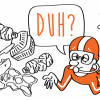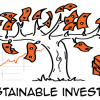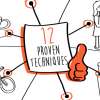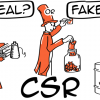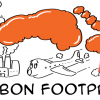Transcript
10 inspiring ways to reuse packaging (Circular economy)
Hi folks, Alex here. Circular economy is about recycling everything really well, right?! Well, no. You have certainly heard about reduce-reuse-recycle. Today we are talking about reusing things and avoiding single use packaging. The Ellen MacArthur Foundation put together a great book with 69 examples of reuse solutions. I won’t cover them all here but I will walk you through my 10 favourites! ok, let’s get drawing!
On this channel, we share tools to help YOU change the worlds so subscribe if you are into that kind of stuff. This book starts with a nice framework to look at how we can reuse packaging and breaks it down into 4 categories: packaging we can refill at home, refill on the go, packaging we can return from home and return on the go.
Return on the go works like this: you purchase a product in a returnable packaging, you use it, you return the packaging and the business cleans and refills it for the next user.
What is the best example of packaging on the go? Right! Coffee. First, let me say this: anybody who likes hot beverages on the go should have a travel mug with them. With that out of the way, for those who really need a coffee and forgot their cup at home, RECUP is a program in Germany that offers cups that can be returned to any RECUP partner in exchange for your original 1€ deposit. Universal and no-branded design enables a large pool of cafés and restaurants participating in the program.
Another solution for “refill on the go” is CoZie: this French company has developed a machine for bulk dispensing of cosmetic products such as face cream, moisturizer, deodorant, etc. The machine stocks the product into airless bags to preserve its shelf life and meet strict specifications for hygiene and traceability. All products come into durable glass containers that can be returned to CoZie against discounts on next refills.
Repack is another return on the go system: when customers from a online store choose the RePack option for their purchase, the order is delivered in a RePack reusable shipper with a prepared return label. A barcode on the shipper ensures that they are tracked and that customers are rewarded when they send them back.
Now, let’s look at the “return from home” category: you subscribe to a service, the business delivers the product to your door, you use it, the business picks it up, cleans and refills it for the next user.
Loop is an online store that delivers your favourite products in durable packaging. When you are finished with the product, they pick it up, clean it up and fill it up again. The Loop store features products from well-known brand-owners such as Procter & Gamble, PepsiCo, Unilever, Haagen Dazs, etc. but they take care of all the logistics for them.
Liviri also offers “return from home” packaging with these reusable shipping boxes to keep meals and perishable items in optimal conditions. The box has built-in insulation, movable partitions inside and reusable ice packs. Either the delivery company owns the boxes or the customers send them back to Liviri via a return shipping label.
Every day in Mumbai, 200,000 meals are delivered and returned in tiffin boxes. Inspired by this system, DabbaDrop delivers ready-made meals to your doorstep in London in reusable tiffin boxes. Customers pay 15 pounds upfront for the container. Each delivery is carried out by bike and the empty box from the previous meal is picked up, washed and reused by DabbaDrop.
Now let’s look at the “refill at home” category: you buy a container, you use it, you buy a refill and refill your container yourself.
Replenish has created this spray bottle for cleaning and personal care. You attach at the bottom a pod with liquid concentrates, you squeeze into a measuring cup to release some product and add water to it in the main reservoir. One pod makes 6 bottles.
“Refill on the go” is pretty self-explanatory: you buy a container, use the product and refill the container on the go.
Algramõ uses electric tricycles to bring to the customers doorstep the vending machine to refill their durable containers. Customers use their smartphone to arrange the visit of the tricycle via the Algramõ app and have an online account for payment, credits and special rewards.
Coca-Cola has developed vending machines so people can refill their own water bottle with customized drinks with bubbles or fruit flavours. A smartphone app helps users track locations and pay online. DASANI PureFill stations are currently being installed on university campuses, schools, hospitals, etc.
This last example does not really fall under the 4 categories because it works at the scale of an entire country: Sweden. The Swedish Return System delivers crates and pallets to the producer where they are filled and shipped to the wholesaler and then to the retail outlet. The retailer empties them and sends them back to the wholesaler. Swedish Return System takes back the reusable crates and pallets and does quality controls and cleaning before using them again. Operated since 1997, it is currently used for half the fresh food deliveries in Sweden!
If you know someone who is looking for an idea to start a business or to join a good one, send them this video or the book. There are so many ways to get rid of all single use packaging!
I received a bunch of emails over the past few months from people asking me what they can to support this channel and my work. Well, the best thing is to make a pledge on Patreon that applies to each new video I will post in the future. It helps me cover the production cost and allows me to stay independent. You can also get perks like your name in the credits of the video, download my drawings to use them for yourself and even you as a character in the next video.
If you can’t contribute financially, not worries. You can always subscribe, share the video with your friends and colleagues. Thanks for sticking around until the end and thanks for watching!

